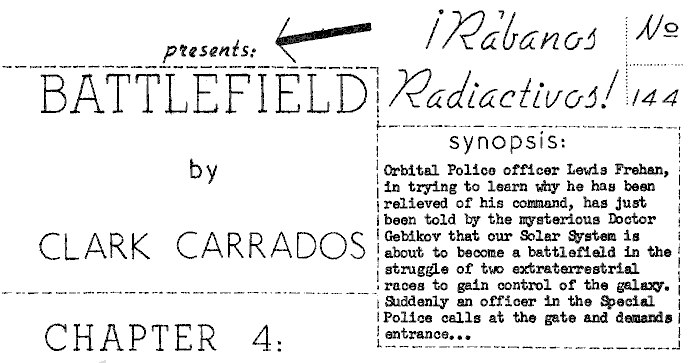

Translation of chapter four of Clark Carrados Battlefield, translated from Spanish to English by Fred Patten. The full text is omitted for reasons of copyright, but in summary:
Rather than be arrested, Frehan accompanies Gebikov and his assistant on their well planned exit, first phoning Sergeant Raymond and asking him to meet them at astroport 4-40. Said planning and some useful discoveries made from observation of alien technology enable their escape via helicopter to the astroport, where they, and Raymond take off in the doctor's space ship. Destination: asteroid T-3391!
| - o0o - | - o0o - | - o0o - |
| **** | **** | **** |
Campo de batalla, por Clark Carrados, Ed. Toray, Barcelona, © 1964. 8ptas. Ch. 4
**************************************************************************************************************************

Good luck to the Triumvirate. Based on last week's performance, we'll have fun watching it in action, if nothing else. No kidding, I hope that Len and Flieg do keep that idea of a formal Apa L Constitution squelched; 'activity requirements' and a 'list of members' are two things we don't need.
Len Bailes -- The firm manufacturing that Looking Glass chess set, adapted from the Tenniel illustrations to the book, is the Adult Leisure Products Corp., of Locust Valley, New York. According to the adv't in PUBLISHERS' WEEKLY, the "suggested retail price" is about $30, and Brentano's in New York is handling them. Possibly anyone wanting a set $30 worth could have somebody going back there for the NyCon act as his agent.
Al Snider -- The fannish currency idea may sound great, but practical difficulties have kept it from becoming a reality for so long that it's hardly worth discussing any longer except as a point of academic interest. On the other hand, the concept of an international interest-group currency can be made to work; the Esperantists have their "steloj" (plural of "stelo", or star) for years, in the forms of paper one stelo notes, and coins of 1, 5, and 10 steloj denominations. All of this has been so successful that in 1965, the international headquarters began minting a silver 25 steloj piece. The money, issued by the Esperanto Foundation, is minted in the Netherlands and has its value pegged on the Dutch guilder; one stelo is worth 7 1/2 cents, I believe. Esperantists all over the world can use it in making purchases from Esperanto bookstores, or in dealing with other Esperantists, because so far it is a hard currency & can be redeemed in a legal money from the headquarters of the organization. I'd say that, if you're going to have a system of fannish currency, your main problem is going to be in finding an issuing organization that can be trusted to last over the years, and to maintain a hard conversion value of the fannish currency into real money. No offense, but I'd be a bit leery of accepting a ValSFA banknote for anything. The idea of bonds is something else again; the LASFS, with its definite goal of trying to raise money for a clubhouse, is just about the only fannish organization in the world that might need something like this. (What's your interest rate, though?)
